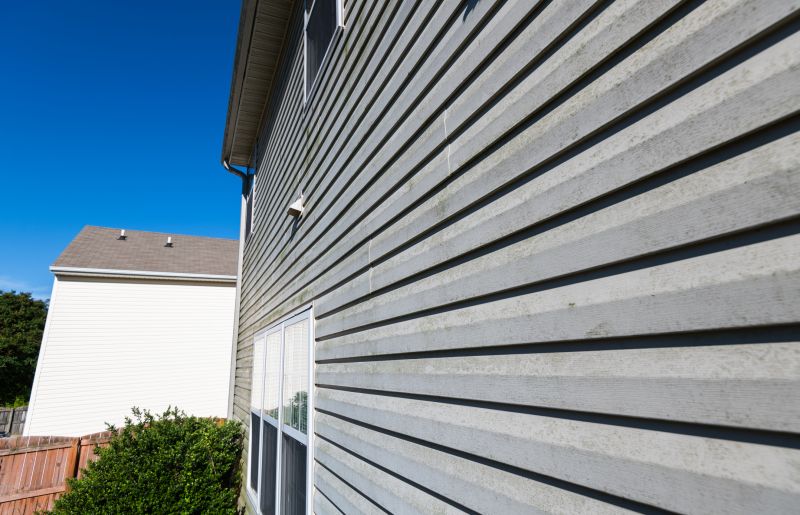Leading Choices in House Siding Replacement Products for Every Budget
Compare affordable to premium siding options that provide excellent protection and visual appeal for your home.
 Replacing house siding is a significant home improvement project that can enhance curb appeal, improve energy efficiency, and provide better protection against the elements. There are numerous siding options available, each with its own set of characteristics, installation requirements, and maintenance needs. From traditional materials like wood and vinyl to modern options such as fiber cement and metal, homeowners can select a product that aligns with their aesthetic preferences and functional needs. The choice of siding can influence the overall look of a home, as well as its durability and longevity.
Replacing house siding is a significant home improvement project that can enhance curb appeal, improve energy efficiency, and provide better protection against the elements. There are numerous siding options available, each with its own set of characteristics, installation requirements, and maintenance needs. From traditional materials like wood and vinyl to modern options such as fiber cement and metal, homeowners can select a product that aligns with their aesthetic preferences and functional needs. The choice of siding can influence the overall look of a home, as well as its durability and longevity.
Top Overall Option
Fiber Cement Siding
Fiber cement siding is a versatile and durable material that offers a balance of aesthetic appeal and resilience. It can mimic the look of wood, stucco, or masonry, providing flexibility in design. Known for its resistance to pests, rot, and harsh weather conditions, fiber cement requires minimal maintenance and can last for decades when properly installed. Its versatility makes it a popular choice for many homeowners seeking a long-lasting siding solution.
Types of Products For House Siding Replacements
Vinyl Siding
Vinyl siding is a popular, cost-effective option that offers a wide range of colors and styles. It is lightweight, easy to install, and resistant to moisture and pests, making it a common choice for many homes.
Wood Siding
Wood siding provides a natural, classic appearance and can be customized with stains or paints. It requires regular maintenance to prevent rot, pests, and weather damage.
Fiber Cement Siding
Fiber cement siding combines durability with aesthetic flexibility, mimicking traditional materials while resisting pests and weather.
Metal Siding
Metal siding, often made of steel or aluminum, offers a modern look with high durability and low maintenance requirements.
Stucco Siding
Stucco provides a textured, seamless finish that can be customized in color and style, suitable for various architectural designs.
Engineered Wood Siding
Engineered wood siding offers the appearance of traditional wood with enhanced resistance to pests and moisture, requiring less maintenance.
Brick Veneer
Brick veneer adds a classic, textured look to homes and provides excellent durability and fire resistance.
PVC Siding
PVC siding is a low-maintenance, affordable option that resists moisture, pests, and fading over time.
Composite Siding
Composite siding combines various materials to achieve specific aesthetic and functional qualities, often emphasizing durability.
Stone Veneer
Stone veneer offers a natural, textured appearance that enhances the architectural character of a home, with relatively easy installation.
Popular Choices
Vinyl siding remains a widely chosen material due to its affordability and variety of styles, making it a common option for many homeowners.
Fiber cement siding is favored for its durability and ability to mimic traditional materials, appealing to those seeking longevity.
Wood siding continues to be popular for its natural beauty and traditional appeal, despite requiring regular maintenance.
Metal siding is gaining popularity for its modern aesthetic and resilience to the elements, especially in contemporary home designs.
Stucco remains a common choice for its textured finish and versatility in architectural styles.
PVC siding is often selected for its low maintenance and resistance to moisture, pests, and fading.
Engineered wood siding offers a balance of traditional appearance and enhanced durability, making it a popular alternative to natural wood.
Brick veneer provides a timeless look with high durability, frequently chosen for its classic aesthetic.
Stone veneer is popular for adding a natural, textured exterior that enhances curb appeal.
Composite siding is increasingly favored for its customizable options and durability across various styles.
When considering siding replacements, it is important to evaluate factors such as durability, maintenance, cost, and ease of installation. Some materials offer a natural appearance and are relatively easy to work with, while others provide superior resistance to weather and pests. Proper installation is crucial to ensure the siding performs as intended and maintains its appearance over time. Consulting with professionals or thoroughly researching product specifications can help homeowners make informed decisions.
In addition to traditional options, there are innovative siding materials that provide unique textures and finishes. These can mimic the look of more expensive materials at a lower cost or offer special features like fire resistance or enhanced insulation. Homeowners should also consider the compatibility of siding with existing structures, local building codes, and the overall style of their home. With the right selection and proper installation, new siding can significantly improve the appearance and structural integrity of a house, making it a worthwhile investment.
Key Buying Considerations
- Durability and resistance to weather, pests, and rot
- Maintenance requirements and lifespan of the siding material
- Compatibility with the architectural style of your home
- Ease of installation and whether professional help is needed
- Cost of materials and installation, including long-term expenses
- Aesthetic options such as color, texture, and finish
- Fire resistance and safety features of the siding material
- Energy efficiency and insulation properties
- Local building codes and regulations regarding siding materials
- Availability of warranties and after-sales support
- Impact of siding weight on existing structure
- Environmental conditions typical to your location
- Potential for expansion or contraction with temperature changes
- Compatibility with existing windows, doors, and trims
- Ease of repair or replacement of sections if needed
